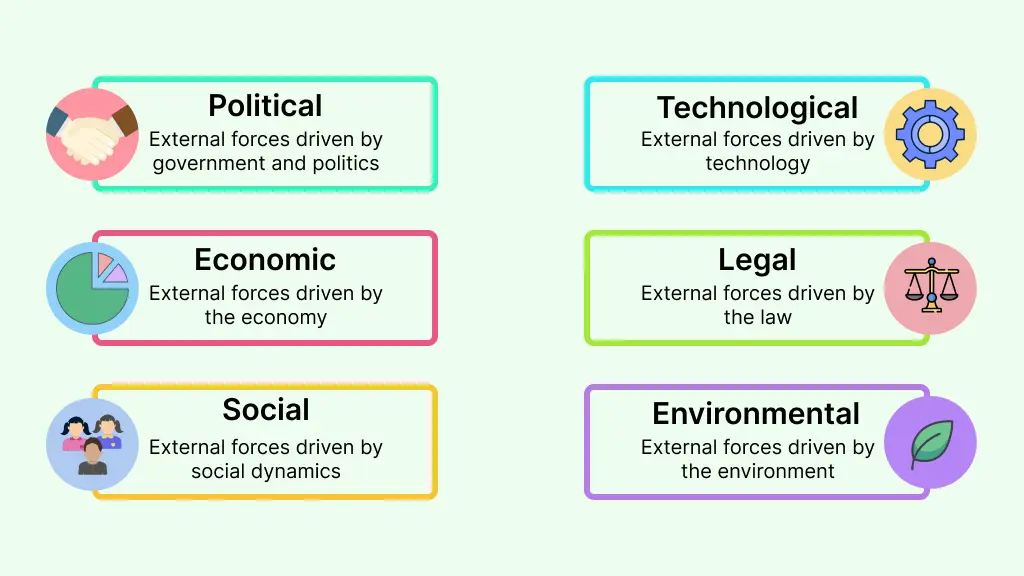Understanding the world around your business is key to making smart, future‑proof decisions. This guide explores a proven framework that helps you see the bigger picture, uncover opportunities, and prepare for challenges in any industry.
PESTLE Analysis Definition
A PESTLE analysis is a way to look at the big outside forces that can shape your business, project, or idea. It’s a strategic framework that helps you think about the political, economic, social, technological, legal, and environmental factors in your wider environment. By understanding these, you can make better plans, spot opportunities early, and be ready for challenges before they happen.
Origin and Evolution
The PESTLE framework traces back to the 1960s when Francis Aguilar introduced the ETPS model, which examined economic, technical, political, and social factors. Over time, this evolved into PEST analysis, and later expanded to include legal and environmental factors, becoming PESTLE (or PESTEL). Today, it’s widely used across industries—from business and government to education and non‑profits—as a reliable way to understand external forces, plan strategies, and anticipate change in a rapidly shifting world.
What Does PESTLE Stand for: Six PESTLE Components
PESTEL stands for six key areas you should look at when studying the outside world that could affect your business:

Political – How government policies, laws, and political stability might influence you.
Economic – The state of the economy, like growth, inflation, and consumer spending.
Social – Changes in society, culture, and people’s values or lifestyles.
Technological – New inventions, digital tools, and innovations that could help or disrupt you.
Legal – The rules, regulations, and laws you must follow.
Environmental – Climate, sustainability, and other environmental issues that can impact your work.
Together, these give you a full picture of the forces shaping your future.
Applications of PESTLE
Planning new business strategies – Understand external factors that could shape your long-term plans.
Entering a new market – Assess political stability, economic conditions, and cultural trends before expanding.
Launching new products or services – Check if timing, regulations, and consumer trends support your launch.
Identifying risks early – Spot potential threats such as regulatory changes or economic downturns before they impact you.
Shaping marketing strategies – Align campaigns with social trends, cultural values, and technological shifts.
Guiding investment decisions – Evaluate external conditions that could affect the success of new investments or expansions.
Supporting policy and project planning – Ensure initiatives are realistic and aligned with the external environment.
Structuring research and reports – Provide a clear, organized framework for academic, consulting, or market studies.
Why PESTLE Matters
Provides a big-picture view: Helps you understand the external forces that influence your business beyond internal operations.
Supports smarter decisions: Offers insights that guide strategic planning and reduce guesswork.
Identifies risks early: Highlights potential challenges like regulatory changes or economic downturns before they impact your business.
Uncovers new opportunities: Reveals trends and shifts in the market that you can leverage to grow and innovate.
Encourages proactive planning: Enables you to anticipate changes rather than just react, keeping your business agile.
Builds resilience: Prepares your organization to adapt smoothly to shifts in the political, economic, social, technological, legal, or environmental landscape.
Advantages and Limitations of PESTLE Analysis
| Advantages | Limitations |
| Comprehensive overview – Covers all major external factors affecting a business, giving a full picture. | Time-consuming – Gathering accurate data on all six areas can take significant effort. |
| Early risk detection – Helps spot potential threats before they become serious problems. | Information overload – Too much data can make it hard to focus on what really matters. |
| Opportunity identification – Reveals trends and changes that can be turned into business advantages. | No prioritization – Doesn’t automatically highlight the most critical factors—you must analyze and rank them yourself. |
| Informs strategy – Supports better decision-making by considering future external changes. | External focus only – Ignores internal strengths and weaknesses, so it should be used alongside other tools like the SWOT analysis. |
| Simple and flexible – Easy to understand and adapt for any industry or project. | Subjective interpretation – Different people may view the importance of factors differently, affecting outcomes. |
| Snapshot in time – Reflects conditions only at the moment of analysis and needs regular updating. |
Examples of PESTLE Analysis
Now that you have an idea about the PESTLE analysis definition and its uses, here are some PESTLE examples for you to get started on your own analysis.
Apple PESTLE Analysis
Adidas PESTLE Analysis
Disney PESTLE Analysis
Uber PESTLE Analysis
Samsung PESTLE Analysis
References
Belsare, H.V. (2020). Article Detail - International Journal of Advanced Research. [online] International Journal of Advanced Research. Available at: https://www.journalijar.com/article/52427/pestle-analysis/.
Citilci, T. and Akbalik, M. (2019). The Importance of PESTEL Analysis for Environmental Scanning Process. Advances in Marketing, Customer Relationship Management, and E-Services, pp.336–357. doi:https://doi.org/10.4018/978-1-7998-2559-3.ch016.
FAQs About PESTLE Analysis
What are the resources needed to conduct a PESTLE analysis?
What is Creately’s AI PESTLE analysis template and how does it work?
Is it PESTLE or PESTEL analysis?
Who should be involved in creating a PESTEL model?
What industries use PESTLE analysis the most?
How is PESTLE different from SWOT analysis?
Can PESTLE analysis predict future trends?
What is the main goal of a PESTLE analysis?






